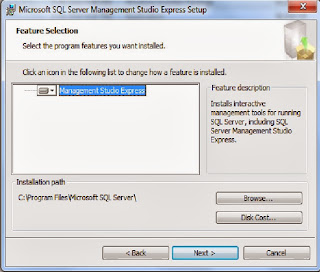The purpose of this blog is to show my journey to learn and become proficient with this technology. As an IT consultant its important to not stay stagnant but prove yourself flexible and competent with a wide array of technologies. Learning HPOO will keep me inline with this goal.
To begin I am going to use mysql express as the underlining database that will support HPOO.
Press next. Choose an authentication that you want for the database then select next.
Choose how you would like to report errors to Microsoft. Then press next.
Press next after the install completes.
Press finished
Now to install the actual sql express. Press the SQLServer2005_SSMSEE_x64.msi to install sql express. Enter your registration info and press next
Press next after you get to the management screen.
See the ready to install screen and press install.
Once it is installed press finish.
Go to the sqlexpress program and right click databases folder and select new database.
Name it oodata and press ok.
Go to the sql server configuration manager and enable tcp/ip
At this point you have configured the database for HP OO. Next is to install Central.
Navigate to the CentralInstaller64-9.00.exe and start it.
See the welcome screen and press next.
Accept the agreement and press next.
Select Microsoft sql server and press next.
Set the DB host, the port number, the database name (for this example we are using OOdata), the user, and the database user. Also check create or recreate database schema?
Press next.
if you keep getting a connection refused and cannot telnet or connect to localhost port 1433 then you may need check out the mssqlserver logs and see what port is listed on the logs to see what it is running on. In my case it was port 49161. After you find the port try to use you microsoft user for the machine name and press next again after you kill central and re run setup.
Found the logs here:
C:\Program Files (x86)\Microsoft SQL Server\MSSQL.1\MSSQL\LOG
It took me an extremely long time to get past this prompt. I ended up going into the icrosoft studio express, enabling the user sa and changing its password. Restarting the database surver in the configuration studio. Once this was all done I was able to get to the following screen.
Create the password for the account admin that you will use by default to login into central. Press Next
Review the summary then press install.
Central is now complete press Finish.
You can verify the central install buy ensuring the HPOO tables are present in the oodata database in the microsoft sql studio.
There should be 27 tables plus the system tables folder.
In addition verify that RSCentral, RSJRAS, and RSScheduler have been created as services during the install of central. To do that go to start type services.msc and look to see those services their.
To verify that Central is up type the following in your browser where hostname = server installed on
https://HOSTNAME:8443/PAS/
in my example it will be https://localhost:8443/PAS/
Here is what HPOO looks like once you log in.
Now to install studio. Studio requires Central to be installed first before you can install it.
Find your installer StudioInstaller64-9.00.exe
Press Next. Accept the agreement and press next.
Keep values as default and press next
Review the summary and press install
To login to studio use the same password you used for central.
This is the homescreen for studio



































No comments:
Post a Comment